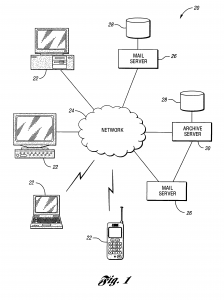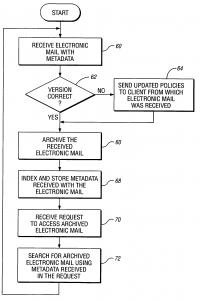Electronic mail metadata generation and management
What It Does (in plain English):
This invention describes a means of processing an incoming email and creating a wide range of metadata and analytics. This metadata / analytics can then be used to better determine how to process email for the efficiency of data storage, SPAM identification, content trends, user presentation, etc. Email servers can apply various types of metadata generation and processing rules based on email server manager policy.
|
Patent Info:
Abstract Electronic mail is archived and retrieved based on metadata generated by the client sending the electronic mail. The metadata is generated based on variable metadata generation policies distributed to each client. The metadata generation policies are executed in each client in conjunction with each electronic mail sent from the client. The electronic mail is received in a mail server on route to at least one addressee of the electronic mail. The received electronic mail is processed based on the metadata attached to the received electronic mail. |
Images:
Claims: Description:
1. Field of the Invention The present invention relates to processing electronic mail such as for archiving and retrieving. 2. Background Art Electronic mail (e-mail) has become a mainstay of corporate and personal communications. Recent analyst figures show e-mail usage to be between 20-30 billion messages per day and growing at an annual rate of 29%. Individual accounts are estimated to receive an average of 7 MB daily. For moderate sized companies, an annual addition of roughly 20 TB of e-mail storage space is required. Electronic mail is no longer limited to text, but typically includes a variety of attachments including word processor files, spreadsheets, slide shows, pictures, video clips, audio clips, embedded graphics, design files, and the like. In addition to traditional e-mail, instant messaging is expected to have 180 million users sending 2 trillion messages per year in the near future. Archiving and retrieving archived electronic mail has become a major concern for many corporations. Information technology departments may spend 25%-35% of their efforts archiving and recovering e-mail. In addition, recent government regulations require e-mail to be archived for at least six years in certain situations. Due to the recent emphasis on e-mail and a probable need for later discovery, more enhanced searching techniques are being developed. Electronic mail indexing and metadata generation is typically performed on a mail server and/or an archive server. Current indexing schemes generally perform keyword indexing and concentrate on common information such as the sender, receiver, time sent, time received, time read, and the like. There indexing methods are insufficient to handle the increasing workload. New and enhanced searching techniques are being developed that will link similar concepts described with different vernacular. Even more futuristic systems are being researched that will better respond to user criteria, span concepts and link related ideas not possible with simple keyword searching. New types of content indexing are processor intensive and will likely impose a greater burden on mail servers and/or archive servers. The type and amount of processing that must be done in order to yield desired results in a timely fashion combined with the abilities of servers and server software will introduce a significant bottleneck in the e-mail system. What is needed is an alternative to the traditional e-mail server configuration. The present invention distributes archival metadata generation to e-mail clients. A method of managing electronic mail received from a plurality of clients is provided. Variable metadata generation policies are distributed to each client. The metadata generation policies are executed in each client in conjunction with each electronic mail sent from the client. Executing the policies generates metadata associated with the electronic mail to be sent. The generated metadata is attached to the sent electronic mail. The sent electronic mail is received in a mail server on route to at least one addressee of the electronic mail. The received electronic mail is archived based on the metadata attached to the received electronic mail. In various embodiments of the present invention, the electronic mail may be archived in the mail server or an associated archive server. The variable metadata generation policies may be generated by and/or sent by either or both of the mail server or the archive server. In another embodiment of the present invention, the metadata accompanying the electronic mail includes a version indicator specifying which policies were used to generate the metadata. A different version of the variable metadata generation policies may be distributed to the client sending the electronic mail based on the version indication. In yet another embodiment of the present invention, a request to access at least one archived electronic mail is received. At least one archived electronic mail is searched for using metadata which accompanied the request. A system for managing electronic mail is also provided. The system includes a plurality of clients. Each client generates electronic mail including metadata based on variable metadata generating policies. At least one mail server receives electronic mail generated by the clients. The mail server processes the received electronic mail for archiving based on the metadata included with the received mail. A method of managing electronic mail utilizing scripts is also provided. A script is developed for generating metadata describing the electronic mail. The script is delivered from a server to a plurality of clients. The script is executed within each client in conjunction with each electronic mail message sent by the client so as to generate metadata describing the electronic mail message. The metadata is then sent to the server. These and other objects, features and advantages of the present invention will be readily apparent upon consideration of the following detailed description in conjunction with the accompanying drawings. Referring to Each client 22 attaches metadata to each e-mail sent. This metadata is generated based on variable metadata generating policies received by client 22 over network 24. The policies are variable in that they can be changed while client 22 is in operation. In some systems 20, each client 22 is sent the same set of policies. In other systems 20, different policies may be sent to different clients or sets of clients based on a variety of parameters such as type of client 22, type of service subscribed to by client 22, organizational group to which client 22 is associated, location of client 22, capabilities of client 22, and the like. Electronic mail system 20 also includes at least on mail server 26. Mail server 26 receives electronic mail from sending client 22 and forwards mail to receiving client 22. Mail server 26 may also include storage 28 for archiving e-mail. Storage 28 may include one or more disk and/or tape drives capable of holding e-mail. Electronic mails system 20 may also include one or more archive server 30 with storage 28 for archiving e-mail. If present, archive server 30 may be directly connected to mail server 26 or may be accessed through network 24. Either or both of mail server 26 and archive server 30 processes metadata received with e-mail to assist in archiving and retrieving e-mail. For example, the metadata may be indexed and stored together with a pointer to the archived location of the e-mail. Subsequent queries requesting archived e-mail include metadata. The indexed metadata is searched for received metadata values. Electronic mail matching the received metadata search criteria is retrieved and returned in response to the query. Metadata that can be processed by the present invention includes a wide variety of information. Simple metadata includes date, time, size, sender, receiver, and the like. An index of keywords may also be included. Metadata generation functions may be used to determine a main idea or theme. Metadata filtering may be used to determine if certain words or phrases are used. For example, shortened expressions such as “r u redy?” are often used in text messaging. Advanced metadata generation may be performed with the assistance of server 26, 30. For example, a system administrator may write metadata generation script. This script is then pushed from server 26, 30 out to clients 22. Client 22 then executes the script on newly generated e-mail. The script may also be used within server 26, 30 on existing e-mail. Thus, new metadata gathering techniques can be generated as needed within an organization. Referring now to Referring now to A check is made to determine if e-mail is to be sent, as in block 44. If so, metadata is generated based on the current metadata generation policies, as in block 46. The generated metadata is attached to and sent with the e-mail, as in block 48. For example, the generated metadata can be included in a mime file sent together with the e-mail message. Referring now to The received e-mail is archived, as in block 66. The metadata accompanying the received e-mail is processed for use in retrieving the archived e-mail, as in block 68. For example, the metadata may be indexed and stored together with an address or pointer to the archived e-mail message. A request to access the archived e-mail is received, as in block 70. The request may be accompanied by metadata specifying the e-mail to be retrieved. A search for the archived e-mail using the received metadata is conducted, as in block 72. While embodiments of the invention have been illustrated and described, it is not intended that these embodiments illustrate and describe all possible forms of the invention. Rather, the words used in the specification are words of description rather than limitation, and it is understood that various changes may be made without departing from the spirit and scope of the invention.



